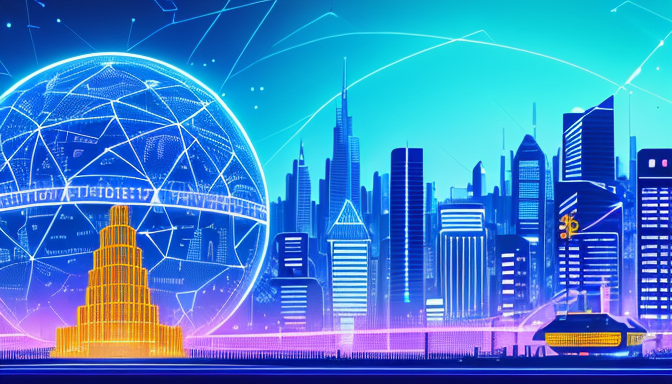Imagine a world where you are the true master of your digital life, where your data is yours to keep, and where every interaction is transparent and secure. Web3 technologies are paving the way for this dream, transforming the internet into a decentralized haven. At the heart of this evolution lies blockchain, a revolutionary technology that ensures transparency and security by allowing data to be stored across a network of computers rather than in a single location. This not only protects your information but also gives you more control over how it is used.
Furthermore, the rise of cryptocurrencies and non-fungible tokens (NFTs) is redefining ownership in the digital realm. With cryptocurrencies, you can engage in peer-to-peer transactions without the need for intermediaries, while NFTs allow you to own unique digital assets, from art to music, in a way that was previously unimaginable. This shift is like moving from a world of traditional banking to one filled with limitless possibilities, where creativity and innovation can flourish.
However, while the potential of a decentralized web is thrilling, it also comes with its own set of challenges. Issues such as scalability and regulatory hurdles must be addressed to fully realize this vision. Yet, every challenge presents an opportunity for growth and innovation. The journey towards a better Web3 world is not just about technology; it’s about empowering users, enhancing privacy, and fostering a new era of digital interaction. Are you ready to embrace this exciting future?
The Promise of Decentralization
Decentralization is not just a buzzword; it’s the future of the internet. Imagine a world where you control your data, where privacy isn’t a luxury but a standard. This is the promise of Web3 technologies, powered by blockchain, cryptocurrencies, and non-fungible tokens (NFTs). These innovations are reshaping how we interact online, creating a landscape where users are no longer at the mercy of centralized platforms.
At the heart of decentralization is the idea of empowerment. Users gain unprecedented control over their digital identities and assets. With blockchain technology, every transaction is transparent and secure, reducing the chances of fraud and misuse. Think of it as a digital fortress where your personal information is locked away, accessible only by you. This shift not only enhances security but also fosters trust among users.
Additionally, the decentralized web ecosystem encourages innovation. Developers can create applications without the constraints of traditional gatekeepers. This opens the door to a plethora of possibilities, from decentralized finance (DeFi) to creative expressions through NFTs. As we explore this new frontier, we must acknowledge the challenges that come with it. However, the potential for a more equitable and inclusive internet is worth the effort.
In summary, the promise of decentralization lies in its ability to reshape online interactions and create a more user-centric digital economy. As we embrace this shift, we can look forward to a future where the internet truly belongs to its users.

Challenges and Opportunities in Web3
As we dive into the world of Web3, it’s essential to acknowledge both the exhilarating opportunities and the formidable challenges that lie ahead. The promise of a decentralized internet is tantalizing, but it doesn’t come without its hurdles. For instance, scalability remains a significant concern. As more users flock to decentralized platforms, the underlying blockchain networks must efficiently handle increased transactions without compromising speed or cost. Imagine trying to fit a growing crowd into a tiny room; it just won’t work!
Moreover, regulatory concerns loom large over the Web3 landscape. Governments are still figuring out how to approach cryptocurrencies and decentralized technologies. The lack of clear regulations can create uncertainty for developers and users alike. It’s like navigating a maze without a map—exciting but potentially risky!
However, where there are challenges, there are also opportunities. The push for user adoption presents a chance for innovators to create user-friendly interfaces and educational resources that demystify blockchain technology. This can lead to a more informed user base that feels empowered to engage with decentralized applications. Furthermore, the rise of non-fungible tokens (NFTs) has opened new avenues for creators and artists, allowing them to monetize their work in ways previously unimaginable.
| Challenges | Opportunities |
|---|---|
| Scalability Issues | Innovative Solutions for High Traffic |
| Regulatory Uncertainty | New Markets for Compliance Solutions |
| User Adoption Barriers | Creation of User-Friendly Tools |
| Security Risks | Advancements in Cybersecurity |
In conclusion, while the road to a fully realized Web3 is fraught with challenges, the potential for innovation and growth is immense. By addressing these issues head-on, we can pave the way for a more decentralized, user-centric internet that not only enhances our online experiences but also empowers us as individuals.
Frequently Asked Questions
- What is Web3 and why is it important?
Web3 refers to the next generation of the internet, focusing on decentralization and user empowerment. It’s important because it aims to give control back to users, enhancing privacy and security while reducing reliance on centralized platforms.
- How does decentralization improve online security?
Decentralization minimizes the risk of data breaches by distributing information across a network rather than storing it in a single location. This makes it much harder for malicious actors to access sensitive data.
- What challenges does Web3 face?
Web3 faces several challenges, including scalability issues, regulatory hurdles, and the need for user education. However, these challenges also present opportunities for innovation and growth in the tech space.
- Can anyone participate in the Web3 ecosystem?
Absolutely! Web3 is designed to be inclusive, allowing anyone with internet access to participate, whether through blockchain applications, decentralized finance, or other innovative platforms.
- How does Web3 foster innovation?
By providing a decentralized framework, Web3 encourages developers to create new applications without the constraints of traditional systems, leading to novel solutions and business models.